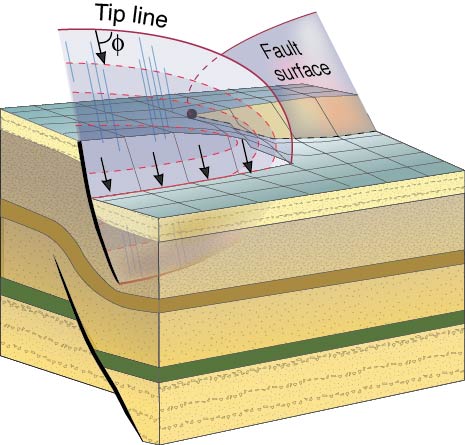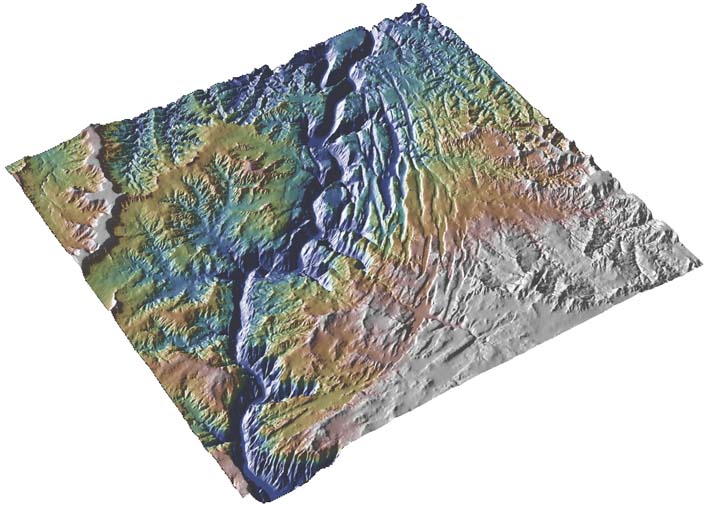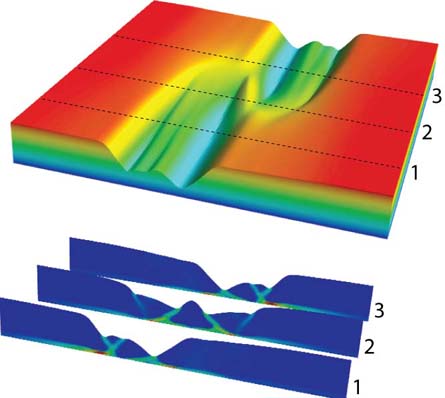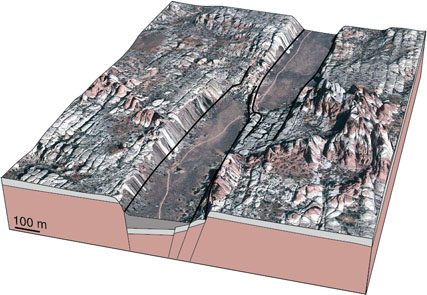
Fault interaction
 We see fault systems and fault populations in many tectonic settings and scales, and they are all end products of a history of fault nucleation, growth and, in most cases, interaction. I find it interesting to read history out of static images based on my experience and recollection of other examples. We talk about mature versus immature stages of fault evolution, which again depends on strain. Useful questions are: did the faults nucleate in a particular (usually strong) layer? did they propagate from the basement up? How much of a control did preexisting basement faults impose on their orientations and spacing? What is the nature of the links and are the links seismically resolvable (when dealing with seismic data)?
We see fault systems and fault populations in many tectonic settings and scales, and they are all end products of a history of fault nucleation, growth and, in most cases, interaction. I find it interesting to read history out of static images based on my experience and recollection of other examples. We talk about mature versus immature stages of fault evolution, which again depends on strain. Useful questions are: did the faults nucleate in a particular (usually strong) layer? did they propagate from the basement up? How much of a control did preexisting basement faults impose on their orientations and spacing? What is the nature of the links and are the links seismically resolvable (when dealing with seismic data)?
Figure: fault interaction is by nature threedimensional.
Relay structures

This is the relay structure in Arches National Park, Utah, hiked by several 100 000 tourists every year. Few of those tourists appreciate the nature of the structure and the fact that it makes for an easy hike between the trailhead and Delicate Arch rather than a stenious climb up the faultscarp.
Relay structures consist of two overlapping fault tips and a somewhat folded volume of rocks in between. If they are allowed to develop further, they will become breached, i.e. transected by one or both of the two overlapping faults. I am interested in all the different stages from soft- to hard-linked structures, including the very small-scale fracture or deformation band populations that develop (see figure to the right). Deformation bands baffle or stear fluid flow, while an anomalously high fracture population wil generally enhance vertical fluid flow in a relay structure. Such locations may even be vertical pathways for ascending magma.
Fault populations
When a number of faults initiate and expand at different places within a volume of rock, they areat various points in time bound to interfere, meaning that their strain fields will overlap. This could also happen as faults grow and "step out of their own plane" – a feature commonly seen along dike intrusions. The way that this happens interests me, as do the consequences that the resulting structures and geometries have on petroleum migration and accumulation. Furthermore, these processes are to a large degree scale independent, meaning that they can be observed from cm-scale features in outcrop or experiments to km-scale faults observable on regional maps or satellite images (e.g., theBasin and Range).

The Grabens area in Canyonlands National Park is a intermediate-scale example of a fault population that show multiple example of fault tip interaction.


Numerical modeing of grabein interaction (left), similar to observations made in Canyonlands (right). From Allken et al., in review.
The dynamics of fault tip interaction
Various stages of fault tip interaction are illustrated below. An understanding of the situation at any given stage is important, for instance to understand the role of such structures in a petroleum reservoir setting. Similarly, it is important to be able to identify the stage of linkage from remote data such as seismic data, with its limited resolution. 
